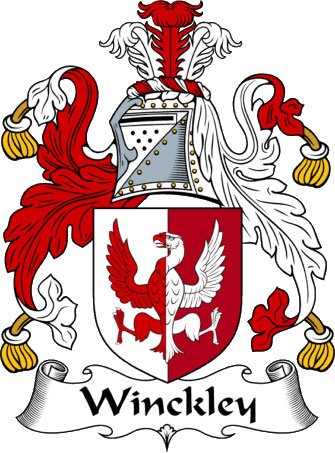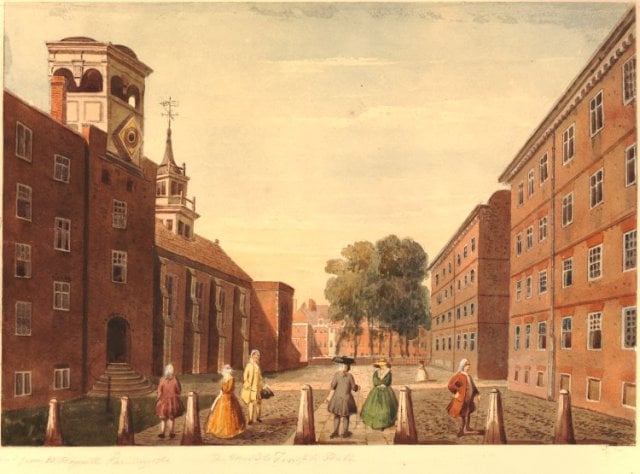
Winckley Square is named after the Winckley family who owned extensive estates in and around Preston. For generations they were significant figures in the life of Preston. They owned the land on which Winckley Square now stands.
The name ‘Winckley’ descends from the Winkelmondelays who, in Saxon times, settled on land at the junction of the Ribble and the Calder near Whalley. The surname Winckley is first found in Lancashire in the Parish of Mitton where they had their family seat as Lords of the Manor of Winckley Hall. The family held the title both before and after the Norman Conquest in 1066.
The Winckley Family were staunch Jacobites. The family had an heirloom, a miniature portrait of King Charles I set in the King’s hair which had been dipped in blood from the scaffold. Frances Winckley remembered wearing it attached to a bracelet as a child on Jacobite anniversaries. She donated it to the South Kensington Museum (c.1790). On the back are engraved the names of family members who adhered to the cause of the Stuarts in 1745 -‘S. Hesketh, R. Hesketh, N. Winckley, T. Winckley.’
The Winckley family of Preston
Thomas Winckley Senior, born in Garstang in 1638, became a lawyer. He married Frances Hodgkinson and, perhaps influenced by his father-in-law’s political views, was soon an active Tory politician in Preston. Elected mayor in 1679, 1688, 1697 and 1705 he was also a steward at the Preston Guilds of 1682 and 1702. He owned a large house on the south side of Fishergate, next to that of Sir John Molyneux, which stood between modern day Cannon Street and New Cock Yard. The burgage extended down to the Syke stream. Thomas purchased estates at Brockholes and Catterall. The Winckley estates also included land at Preston, Claughton, Kirkland, Samlesbury, Ribbleton, Fulwood, Balderstone, Walton le Dale and Cuerden. Thomas was buried at Preston in 1710.
John, his eldest son and heir, a barrister at Lincoln’s Inn, married Margaret, eldest daughter of Nicholas Starkie of Huntroyd. They had four daughters. Sarah, married Roger Hesketh of Rossall and Tulketh. Margaret, married Edmund Hornby of Scale Hall in 1749 whose son, Reverend Geoffrey Hornby, placed a wall memorial to his parents and their daughters in St Chad’s church at Poulton le Fylde. Frances, who did not marry. Stone memorials at Bath Abbey record the burial in 1756 of Elizabeth who also never married.
John and Margaret also had four sons. Thomas ,who died in infancy. John (Junior), about whom nothing more is recorded but that he died unmarried. When John Winckley Senior died in 1753 his eldest surviving son, Nicholas, was his heir. Nicholas owned over 80 acres of land in Preston by 1774. Nicholas and his wife Anne Hulton had an only son, Henry, buried at Broughton in 1675. When Nicholas died in 1792 his brother, and John Senior’s fourth son, Thomas, inherited all his properties.
Thomas Winckley, named after this grandfather, was born c. 1731 in Preston and lived in the large family home on Fishergate. Thomas as the fourth son of John Winckley and Margaret had been destined for the law as he was not expected to inherit the family estate. He entered the Middle Temple in 1763 at the age of 32. However, Thomas did inherit his father’s estate in 1792 at the age of 61 and in the same year he sold the land on which St Wilfrid’s stands to Father Dunn (aka Daddy Dunn.) He might have planned to sell the land on which a part of Winckley Square now stands but he died in 1794; two years before it was sold to William Cross

Thomas Winckley’s marriage to Lady Jacintha Hesketh 25th July 1785
On 25th July 1785 Thomas, then aged 54 and living in his home on Fishergate, married Lady Jennet (Jacintha) Hesketh (née Dalrymple) daughter of Hugh Dalrymple, an Edinburgh lawyer, and widow of Captain Thomas Hesketh of Rufford who died age 32, in 1781, as a result of injuries incurred during the American War of Independence. Captain Hesketh and his wife Jacintha had had five daughters and a son, Thomas Dalrymple Hesketh, born in New York in 1777 who became the 3rd Baronet of Rufford.
Thomas Winckley and Jacintha had two children. Margaret their first born child died in her first year in 1786. Frances Winckley, the second child of Thomas and Jacintha, was born in Preston on 16th June 1787 in the Fishergate house. She was named after her grandmother Frances Winckley (née Hodgkinson) and Thomas’s sister.
Frances wrote in her diaries:
“My five half-sisters lived in another house in Preston, while their brother, Sir Thomas Hesketh, who had succeeded to his uncle’s title and property, was at a private tutor’s in Kent. As my father had taken a great dislike to the Heskeths, we rarely met. I fancy that my mother’s home was not a happy one. My father, having been a younger son, was accustomed to live in the Temple, where he led a bachelor’s life, which he preferred to his country home.”
N.B. the Temple refers to the legal heart of London.

© The Trustees of the British Museum
Frances said her father rarely visited Preston, which she described as their ‘country’ home. Preston in the 18th Century and prior to the manufacturing era was a gentrified town where many wealthy people owned mansions and large houses.
Thomas Winckley was an attorney and a wealthy landowner. The family continued to live in the large house on Fishergate. He owned Town End Field which was to become the north part of Winckley Square.
The Winckley family leave Preston
By 1794 Thomas Winckley had become disgusted with the erection of factories in Preston – In his view “Proud Preston”, as the winter residence of the nobility and county families, was losing its appeal.
Frances wrote in her diary:
“One day my father, in a towering passion, left his old house never to return. He had gone as usual in the morning to select his fish for dinner. On his arrival at the fishmonger’s he found himself forestalled, in the purchase of the finest turbot, by a Mr. Horrocks, a cotton spinner. This was too much for my father’s sense of dignity. He pronounced Preston was no longer a fit place for a gentleman to live in and immediately rented a villa situated about six miles out of Liverpool – then a rising but still small town. The house stood on a beautiful hill overlooking the Mersey”
In 1791 John Horrocks moved into a small workshop in Turk’s Head Court, off Church Street. There he produced best quality yarn and began to ‘put it out’ to handloom weavers who made it into cloth in their homes. His business grew rapidly and in 1791 his first factory was built in Dale Street. When Thomas Winckley encountered him in the fishmongers John Horrocks had already built 3 factories in Preston.
Thomas Winckley dies 1794 revealing a secret
Thomas died soon after the move to the outskirts of Liverpool when Frances was six. We don’t know at what point Jacintha was aware of Thomas’ illegitimate children.
Thomas Winckley’s will was written in October 1785 just 3 months after his marriage. He had fathered two illegitimate sons before marrying Jacintha. He left an annuity of £40 a year to ‘Alice Dobson late of Lytham, single woman, now residing at Capt. Broadley’s at Dover under the assumed name of Mrs. Wilson’ and to his natural sons by her, Thomas ‘near 19 years old’ (named after his grandfather and himself) and Nicholas ‘about 15 years old’ (named after Thomas’ eldest brother and maternal Grandfather).
Nicholas was at the Rev Lawrence’s Free School at Kingston-on-Thames and was left £1,200 and Thomas was to be apprenticed to Hammond & Richardson’s Brewery in Castle Street, Long Acre, Westminster (Combe & Co. Woodyard Brewery) in addition to a £1,000 inheritance. The will states that both sons were registered at their baptism with the surname of Wilson but ‘have been called Winckley for several years.’
There is no further trace of the eldest son Thomas, but in 1787 Nicholas was probably apprenticed to Richard Barnes, an attorney of Reigate in Surrey. He joined the Honourable Society of the Middle Temple in 1795 (where his father had previously been a member and was fully acknowledged as his father’s youngest son in the admissions’ register) and died aged 58 on the 21st March 1831. He is buried in the Temple Church in the City of London.
Soon after Frances’ birth Thomas added a codicil to his will in 1788, making her tenant for life of his real estate. Earlier, in 1785, Thomas had left his house and furniture to Jacintha and the rest of his estate to his sisters Sarah and Margaret Hornby (née Winckley) and the sons of his nephew Reverend Geoffrey Hornby.
Clearly there was a change in the arrangement Thomas had with Alice Dobson. In 1792 he made a second codicil revoking the Annuity to Alice, ‘…she having lately had a more ample provision made to her by some other friend’. He also revoked the legacies to his illegitimate sons since they had already been paid large sums for their ‘preferment in the world’.
Following their move to Liverpool in 1794 Thomas added a codicil which left the household goods of ‘Larkfield’ to Jacintha. Thomas died shortly after the move to Larkfield.
The Winckley family name ended when Thomas Winckley died in 1794.
Frances Winckley, being the only ‘legitimate’ child of Thomas, inherited all his properties and lands at the age of six. Rev. Geoffrey Hornby, son of Thomas’ sister Margaret, was made Frances’ guardian and administrator of the will. Town End Field was sold to William Cross in 1796.
When Frances married John Shelley, 6th Baronet of Michelgrove and Maresfield in 1807, all the Winckley properties became the property of the Shelley family. An event that did not please her half siblings from her mother’s previous marriage to Thomas Hesketh. (Frances’ diary). Read more about her life on this website
Useful Sources
See the Useful weblinks on website.
The Diary of Frances Lady Shelley 1818-1873 Edited by Richard Edgcumbe
My Lady Scandalous: Jo Manning, Simon and Schuster 2005
By Patricia Harrison & Trevor H Kirkham who contributed to A Portrait of Winckley Square Preston: Frances Winckley Shelley p151